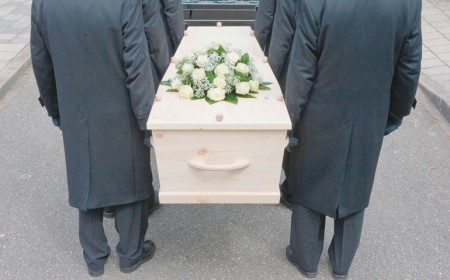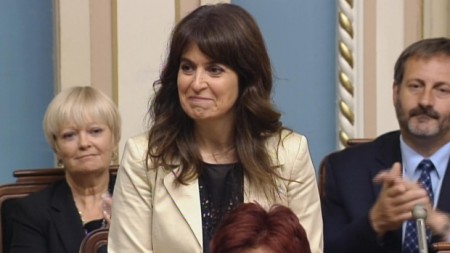Let’s put a smile on that face, shall we?

Enhancing Life Near Death
by Beverly Amsler
Peanut, Bootsie, Choppie, Sassy Mae. They’re a collection of names engraved into the flat stones marking the graves of dogs and cats at Mountain View Cemetery, a resting place in Vinton, Va., run by Don Wilson.
“We see people coming to visit and pay their respects and remember their pets in this section just as we do in the rest of the cemetery,” Wilson says.
Across the country, there are cemeteries for people, and cemeteries for pets. But in the past few years, some states have passed laws allowing cemeteries to create sections where pets and humans can be buried next to each other. Virginia is about to become the latest state allowing cemeteries to designate sections where pets can be buried next to their beloved owners.
Pets have been buried at Mountain View for four years now, in a section separated from human plots by a row of short, green shrubs.
Starting in July, Wilson, who runs five cemeteries, will able to designate a separate section of land in them for humans who want to be buried beside their pets.
Tom Rakoczy and his wife moved from Ohio to Virginia so they could be buried in a plot next to their 11 dogs.
“For my wife and I — our dogs, they’re our family,” he says. “Loved ones could come with two legs or four legs. And our dogs, for the last 40 years of our marriage, have been our family. We have no human children.”
Virginia joins a growing number of states, including Pennsylvania and New York, where cemeteries are allowed to create special pet-human burial sections.
The law was spearheaded here by Kelly Farris who owns a funeral service in Abingdon, Va. A few years ago, he and his family set aside some land for a future “Garden of Loyalty.”
“I think that we’re just progressive and we thought of something with the help of our clients, basically. To me it was a commonsense thing to do,” Farris says.
He currently has a waiting list of 25 people. When the law goes into effect, he can start the burials. Pets will have to be in special caskets, he says.
“Just like for humans, they’re going to have to be in an outer burial container, because we got to maintain the appearance of the graves forever,” he says. “There are pet caskets; there’s companies out there that we use that have caskets designed for different sizes of [animals]. Primarily it’s cats and dogs that we’re working with.”
In Pennsylvania, cemeteries have had separate pet-human sections for the last eight years.
Hillcrest Memorial Park, in western Pennsylvania, was the first to set up this type of cemetery, and owner Tom Flynn estimates that 80 people and pets have been buried in what he calls the “People and Pets Garden.” He says some of the pets buried here are waiting for their owners to join them. Some owners already buried here are waiting for their pets.
“People buy ahead of time so they can be buried with their pets. Some people even exchanged their lots in the cemetery for lots in the ‘People and Pets’ section. It’s over a hill; it’s probably the prettiest part of the cemetery,” Flynn says.
In Virginia, the new state law doesn’t require cemetery owners to set up a joint pet-human burial section. It merely allows them to.
Wilson of Mountain View Cemetery has no plans to create one; he doesn’t have enough land, he says. But, like most businesses, cemeteries are supply and demand.
Wilson says if there’s enough interest, he’ll reconsider.
Complete Article HERE!
By Heidi Schlumpf
 When I heard that my friend Linh’s father had passed away, I knew I wanted to go to the funeral. Her father, who had fled Vietnam with his family during the war, had been especially kind and welcoming to our son, who was adopted from Vietnam. He had made us feel like family.
When I heard that my friend Linh’s father had passed away, I knew I wanted to go to the funeral. Her father, who had fled Vietnam with his family during the war, had been especially kind and welcoming to our son, who was adopted from Vietnam. He had made us feel like family.
The funeral Mass was at his home parish, which was about an hour from my home. The pastor from that church, as well as from the parishes that are the base for Vietnamese Catholics in Chicago and from the local Divine Word Missionary community, concelebrated. There must have been almost a dozen of them. Parishioners from his parish and beyond were there too, as well as almost 100 family members, who wore traditional white headbands. The church was packed.
Since the liturgy was in Vietnamese, the only responses I could join in on were “Amen” and “Alleluia.” But the eulogy by the youngest son was in English and brought tears to my eyes. I was sad for my friend, for her widowed mother and for her children who had lost a grandpa.
At the end of the funeral, we were invited to the cemetery for the graveside service, to be followed by a luncheon. I assumed it was only for close relatives, but everyone else seemed to be going, so I got the “Funeral” sticker for my car and joined the procession.
At graveside, there were more prayers and songs — again in Vietnamese. Then the massive floral arrangements, which had been brought from the church, were dismantled, and the flowers distributed to people in the crowd.
The gravediggers were called to lower the casket into the ground. Next, they backed up a nearby crane and lowered a cement slab over the casket. We all waited patiently. Then we all threw our flowers into the casket-sized hole in the ground. While everyone stayed and chatted, visiting nearby graves, Linh’s 6-year-old daughter tossed every last flower into her grandfather’s grave.
What a powerful and moving example of “burying the dead.”
Burying the dead seems like the lonely stepchild of the corporal works of mercy. The others — feeding the hungry, giving drink to the thirsty, clothing the naked, sheltering the homeless, and visiting the sick and imprisoned — are embraced by Catholics committed to social justice, with entire ministries and even nonprofit organizations created to try to meet those needs.
But burying the dead? That ministry is usually left to priests, close friends and relatives, and the dedicated parishioners (often retired women) who sing at funerals or serve post-funeral luncheons in church basements.
Catholics of all ages — especially social-justice-minded ones — should remember that burying the dead is just as important as feeding the hungry and sheltering the homeless. Being part of a proper burial not only maintains the deceased person’s human dignity and is a service to the survivors, it also benefits the church and broader culture by offering ritual and meaning when people need it most.
Although burial of human remains in the ground may have begun as an efficient way to dispose of decomposing bodies, it acquired ritualistic and religious significance early on. For Catholics, burial of the deceased is not only a sign of respect but connected to our belief in the resurrection of the body. Burial is still preferred to cremation, which is now allowed by the church, “unless it has been chosen for reasons which are contrary to Christian teaching” (Canon 1176).
To be clear, I’m not just arguing for comforting the sorrowful — a related spiritual work of mercy — although certainly Catholics should consider spending time with widows or widowers, praying for those affected by the death of a family member, or perhaps volunteering at a hospice or hospital.
No, I mean actually attending wakes and funerals, including burial and graveside services. I know funerals are often held during business hours on weekdays, inconvenient for working people, but what could mean more to a family than their faith community accompanying their loved one to a final resting place?
The other six corporal works of mercy are taken directly from Matthew 25 (“Whatsoever you do to the least of my brothers and sisters …”), the parable of God’s judgment. Burying the dead was added to make the list a spiritually significant seven. The admonition to bury the dead comes from the Old Testament Book of Tobit, whose namesake is exiled for his righteous work of burying the dead, especially criminals.
Like Tobit, we should help bury not only our own deceased friends and family members, but others as well. This could include attending funerals of those in our community whom we did not know well in life, or even assisting, financially or practically, organizations that help low-income folks with funeral expenses (which today run in the thousands of dollars).
In our death-avoidant culture, it’s understandable that attending funerals is something many prefer to avoid. But I can’t think of anything more merciful than helping to ritualize the end of a life. My friend’s Vietnamese community has it right. Complete Article HERE!
I have an interesting exercise for you.
I want you to write your own obituary. Just like you would want it to appear after your death. You can be as creative as you like.
Try to remember that this is just an exercise, okay? A wise man once said that we are unable to manage what we cannot measure. And this is an opportunity for you to take measure of who and what you are. Give it some thought. As the saying goes: Things that are difficult for us will tell us more about ourselves than the things we do with ease.
Take some time over the next week or so to review examples of obituaries and death notices…they’re in all the newspapers and online. Now write your own obituary. You died today. What would you like to say about yourself and your death? Model it upon the ones you researched or be creative and design your own. Remember, this is just a snapshot of who you are at this moment. It would be interesting to compare this obituary with the one that you might write at the next year or when it is truly needed.
Excerpts From World Class Obituaries:
Ronnie loved spur-of-the-moment trips in luxury cars to Vegas with his friends. We would also like to thank the people who issued his credit cards.
Allison studied cooking to prevent recurrences of memorable culinary disasters and fend off resulting “blond” jokes.
When you remember Brett, remember he was more than a great set of biceps; he was also an incredible set of pecs.
She is remembered for her endless capacity to love, her romantic ideals, her wit, her sense of humor, her homemaking and her ability to accessorize.
Jenette is probably shrieking from the other side now that her true age has been published.
Handsome and tailored to a fault, he somehow still managed to wear too much jewelry.
William, the proud owner of an outrageous giant poodle named Orbit, could often be found in his red pumps on Bernal Hill or high in the Sierras.
Here’s to short skirts, tall hairdos, seamed stockings, and bad attitudes!
He lived in San Francisco according to the Gospel of Mame and believed implicitly in the virtues of room service and frequent flyer miles.
Ron loved collecting ‘50’s memorabilia as well as dining out and drinking Merlot and driving his treasured 1961 Cadillac — sometimes unfortunately in that order!
She lived by the words of Alice Roosevelt: “If you haven’t anything nice to say about someone, come sit next to me.
Weary of reading obituaries noting someone’s courageous battle with death, Mike wanted it known that he died as a result of being stubborn, refusing to follow doctors’ orders and raising hell for more than six decades. He enjoyed booze, guns, cars, and younger women until the day he died. So many of his childhood friends that weren’t killed in Vietnam went on to become criminals, prostitutes and/or Democrats. He asks that you stop by and re-tell the stories he can no longer tell. As the Celebration will contain adult material we respectfully ask that no children under 18 attend.
 Terminally ill patients in Quebec now have the right to choose to die.
Terminally ill patients in Quebec now have the right to choose to die.The non-partisan Bill 52, also known as an act respecting end-of-life care, passed Thursday afternoon in a free vote at the National Assembly in Quebec City.
‘Dying with dignity means dying with the least amount of suffering,’— Véronique Hivon, PQ member of the National Assembly
The bill passed 94-22. There were no abstentions.
“Sometimes when you are suffering in pain, one hour can feel like one week.… The protection of the vulnerable is reflected in every aspect of this bill,” said Parti Québécois member of the National Assembly Véronique Hivon, who drafted the bill when she was minister of social services under the former PQ government.
Bill 52 allows for and outlines under which conditions terminally ill Quebecers can request to receive medical aid in dying.

Health Minister Gaétan Barrette, right, stood with members of the National Assembly from the three other parties (including Véronique Hivon, who drafted the bill) in late May to affirm the cross-partisan support for Bill 52. (CBC)
The main indicator for requesting medical aid in dying is “an incurable disease, an incurable illness, which is causing unbearable suffering.”
“For me, dying with dignity means dying with the least amount of suffering … and respecting who that person always was during his or her whole life,” Hivon said in the National Assembly before the vote took place.
Her speech was followed by applause and a standing ovation.
Liberal Christine St-Pierre was one of the 22 who voted against Bill 52.
“I don’t believe it’s right to give [anyone] the power to kill somebody,” St-Pierre said.
This legislation is the first of its kind in Canada. Its passage comes at a time when the right to die is being heavily debated in the rest of the country.
The Parti Québécois tabled the bill nearly a year ago after years of work from both the PQ and the Liberal government that came before it.
A committee on dying with dignity was assembled during Jean Charest’stenure as Quebec premier to study the issue and produce a report.
Its massive report, filed in March 2012, provided the foundation for Bill 52.
However, Liberal Leader Philippe Couillard refused to play ball with the PQ when the party tried to force the bill into passage right before calling an election. Bill 52 died on the order paper as a result.
During the 2014 Quebec election campaign, Couillard promised to reintroduce the bill as it was drafted at the earliest possible moment during the new parliamentary session.
He also got the support from all four parties to reintroduce the bill at the stage it had died, instead of starting from square one.
It was reintroduced in late May by the new Liberal government.
Liberal Health Minister Gaétan Barrette made that announcementwhile standing side by side with MNAs from the three other parties.
“Between the four of us, we think the bill will pass strongly,” Barrette said at the time.
Complete Article HERE!